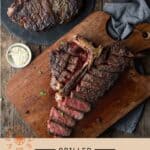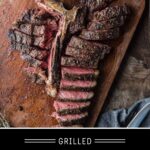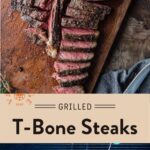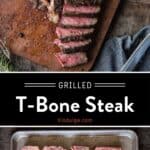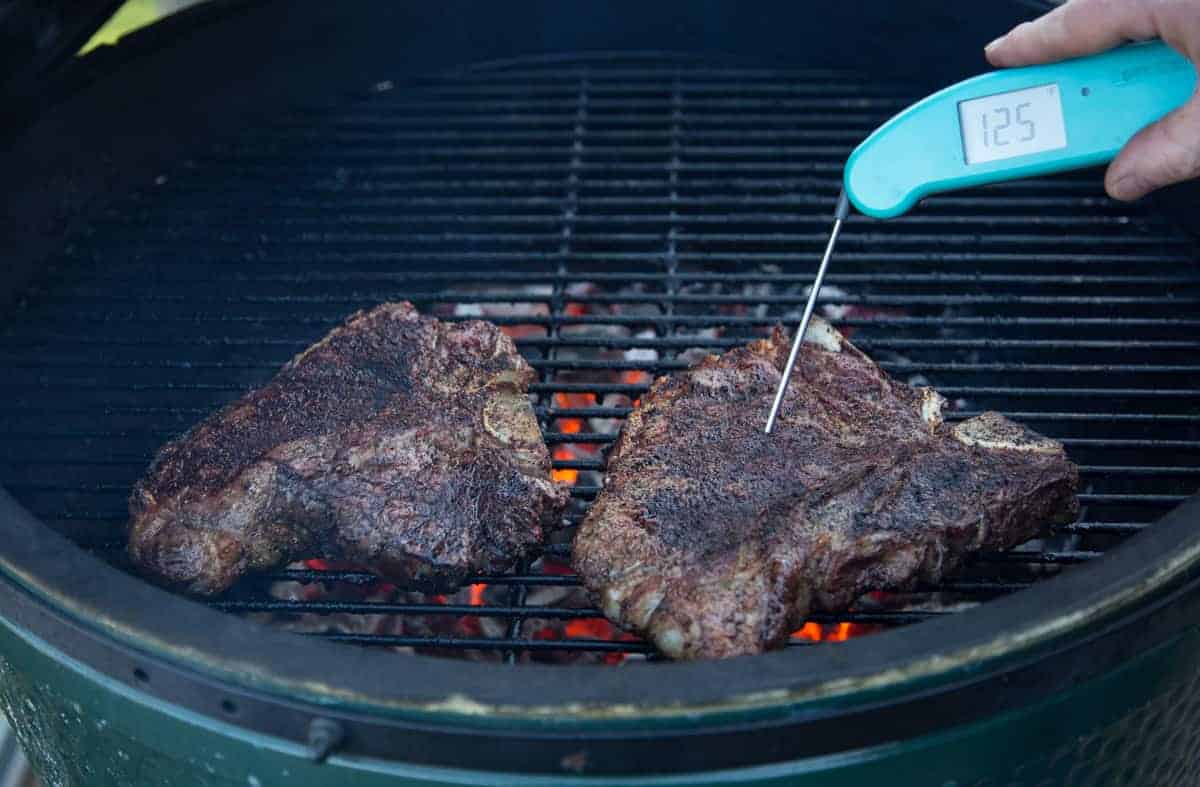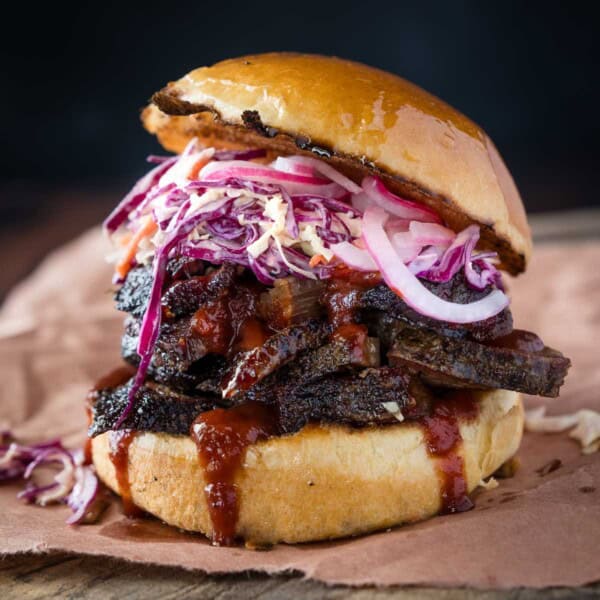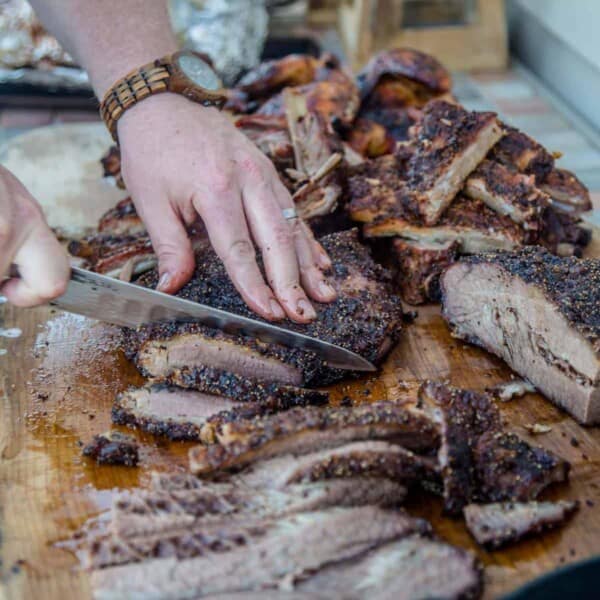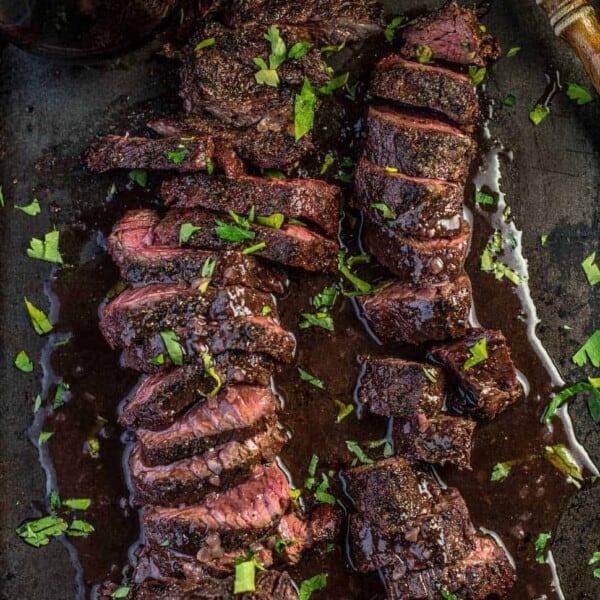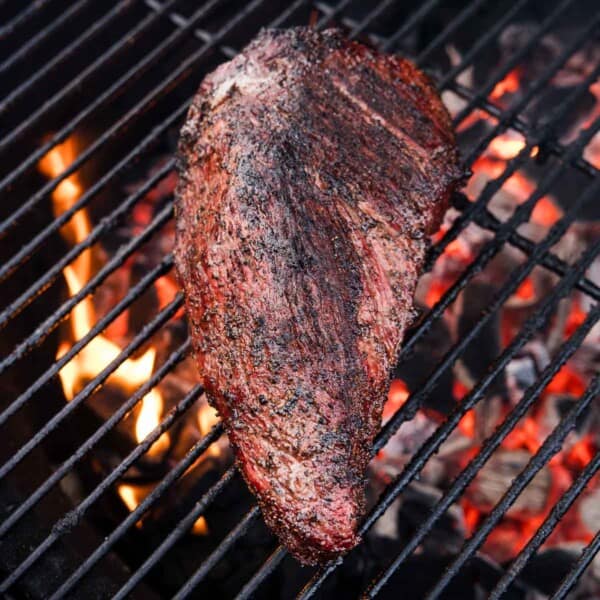This post may contain affiliate links. Read more at our disclosure policy.
Learn how to grill a perfect T-Bone Steak every time. The best steak advice is to cook hot and fast over charcoal to the proper internal temperature. You’re going to love this Grilled T-Bone Steak recipe and return to it over and over!
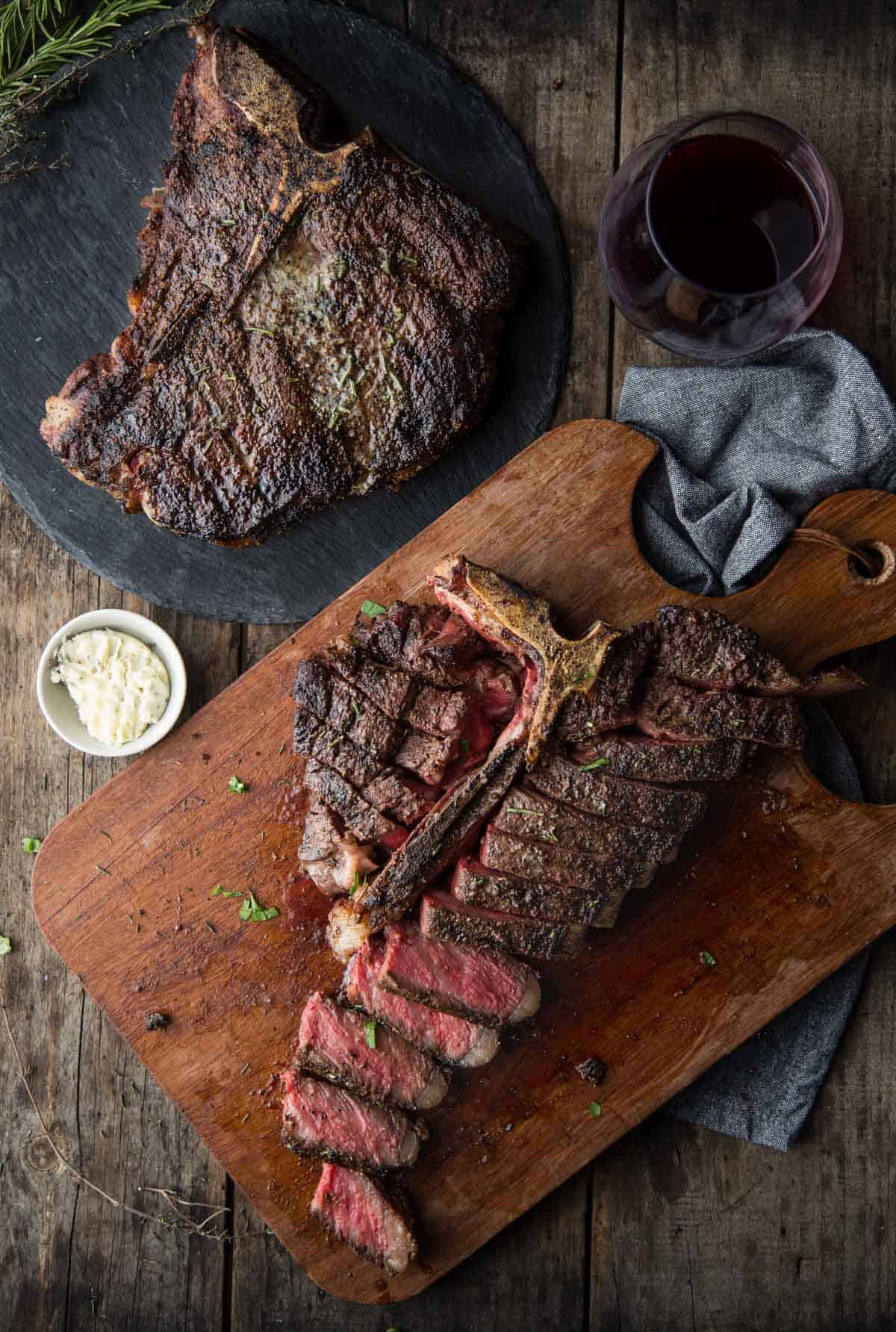
When it comes to cooking steak it is all about technique. The best way to cook a T-Bone steak is to grill it. It requires some precision because it consists of two different cuts of meat, but it’s easy to get the hang of.
The secret to perfectly grilled T-bone is to start with a hot heat source, use a thick cut of steak, and use a meat thermometer to pull it at the proper internal temperature. Let’s get started!
Table of Contents
- Ingredients
- What is T-Bone Steak
- Porterhouse Versus T-Bone
- Sourcing
- Grilling Versus Oven
- How to Grill a T-Bone Steak
- Gas Grill
- T-Bone Slicing Tips
- Thin Steak Troubleshooting
- Chef Steak Temperature Ranges
- BBQ T-Bone Steak
- Wine Pairing for T-Bone Steak
- Tools Used
- Frequently Asked Questions
- Best Sides for T-Bone Steak
- Our Favorite Steak Recipes
- Easy Grilled T-Bone Steak Recipe
Ingredients
- T-Bone Steak – Be sure you buy a thick-cut steak that is at least 2 inches thick. The thickness of the steak helps you prevent overcooking it when grilling. This large steak size is good portions for two people.
- Steak Seasoning – You can go with a simple seasoning like our SPG seasoning, or you can enhance the flavor using our savory steak seasoning. They key is to avoid using any seasoning with sugar (this is because sugar, cooked over direct flame, can easily burn resulting in unpleasant flavors).
- Finishing Sauce or Butter – An optional finishing steak sauce or steak compound butter will enhance the flavor but is totally optional. Add the sauce or butter as the steak rests after it’s grilled.
What is T-Bone Steak
A T-Bone steak is a combination of two cuts of meat from the short loin — the Beef Tenderloin and Strip Loin — so you’re getting two distinct flavor profiles. They are separated by a T shaped bone with the muscles on each side of the bone (see photo below).
The beef tenderloin is the smaller cut and is very tender and lean cut of beef. The strip loin side (sometimes referred to as the NY Strip loin or NY Strip steaks) has more marbling. The flavor of the steak is rich and juicy.
Porterhouse Versus T-Bone
A lot of people confuse the Porterhouse Steak and the T-Bone. They are essentially the same cut, except the Porterhouse has a wider beef tenderloin cut that is more like the filet mignon.
The Porterhouse is the larger of the two cuts and has a more distinct tenderloin as it comes from closer to the rear of the cow. Because the T-Bone is further toward the front of the short loin, there is a much smaller portion of the tenderloin as it tapers off. Technically for a T-Bone to be labeled as such, the tenderloin cut needs to be between .5 inches and up to 1.25 inches.
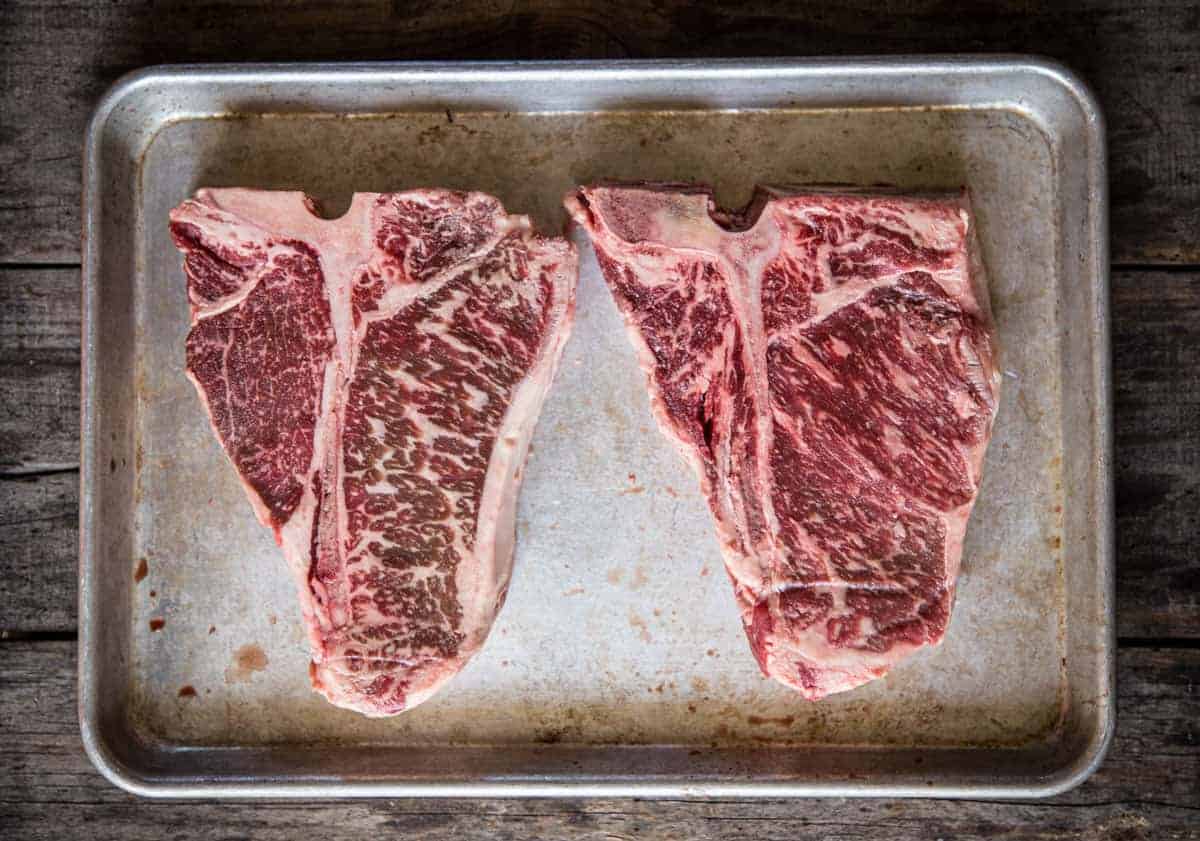
Over 1.25 inches you are in Porterhouse territory and you are typically paying more per pound for a Porterhouse to get that label (and a bigger tenderloin).
Sourcing
If buying locally, be sure to look for marbling, or the white deposits in between the muscle fibers. And if you are wondering about rating quality you can see a summary in our article about Choice vs. Prime.
Online purveyors of steaks will occasionally have T-Bones, like Snake River Farms, Double R Ranch, and Crowd Cow for Choice and Prime. D’Artagnan is a good choice for small farm-focused meats. In the end, any local butcher should have these cut up for you and ready to go.
If sourcing in a grocery store try to buy from the butcher counter. Often the pre-packed steaks are thin steaks, which can overcook easily regardless of cooking method. The theme here is buy thick steaks.
Grilling Versus Oven
You can cook the T-Bone by searing in a hot skillet and finishing in a preheated oven (425 degrees), like they often do in a restaurant. But if you want to know how to cook a T-bone steak for THE most flavor, it has to be grilled. The reason is the rich flavor that comes from lump charcoal and the high heat sear you can get is tough to replicate using a pan and an oven.
How to Grill a T-Bone Steak
- Prepare a grill for two-zone cooking. This allows one side to be searing hot, targeting 500 degrees Fahrenheit over the direct side, and then to have a side without charcoal, making it easier to finish the steak and not burn the outside.
- Add a light coating of extra virgin olive oil to the raw meat. Season both sides of the steak simply with your steak seasoning.
- Grill the steak over direct heat, roughly 4-5 minutes, or until a nice crust develops.
- Flip the steak over direct heat and sear the other side another 2-3 minutes or until a nice crust develops, and then move the steak over indirect heat to finish cooking.
- Finish the steak over indirect heat until the internal temperature of the steak is at your desired internal temperature at the thickest part of the steak. Use a high quality instant read thermometer, like the Thermoworks Thermapen One to get an accurate read of the internal temperature.
- Let the T Bone steak rest for 10 minutes and then serve. Letting it rest allows carry overcooking to allow the steak to finish off the heat for a mouth tender steak.
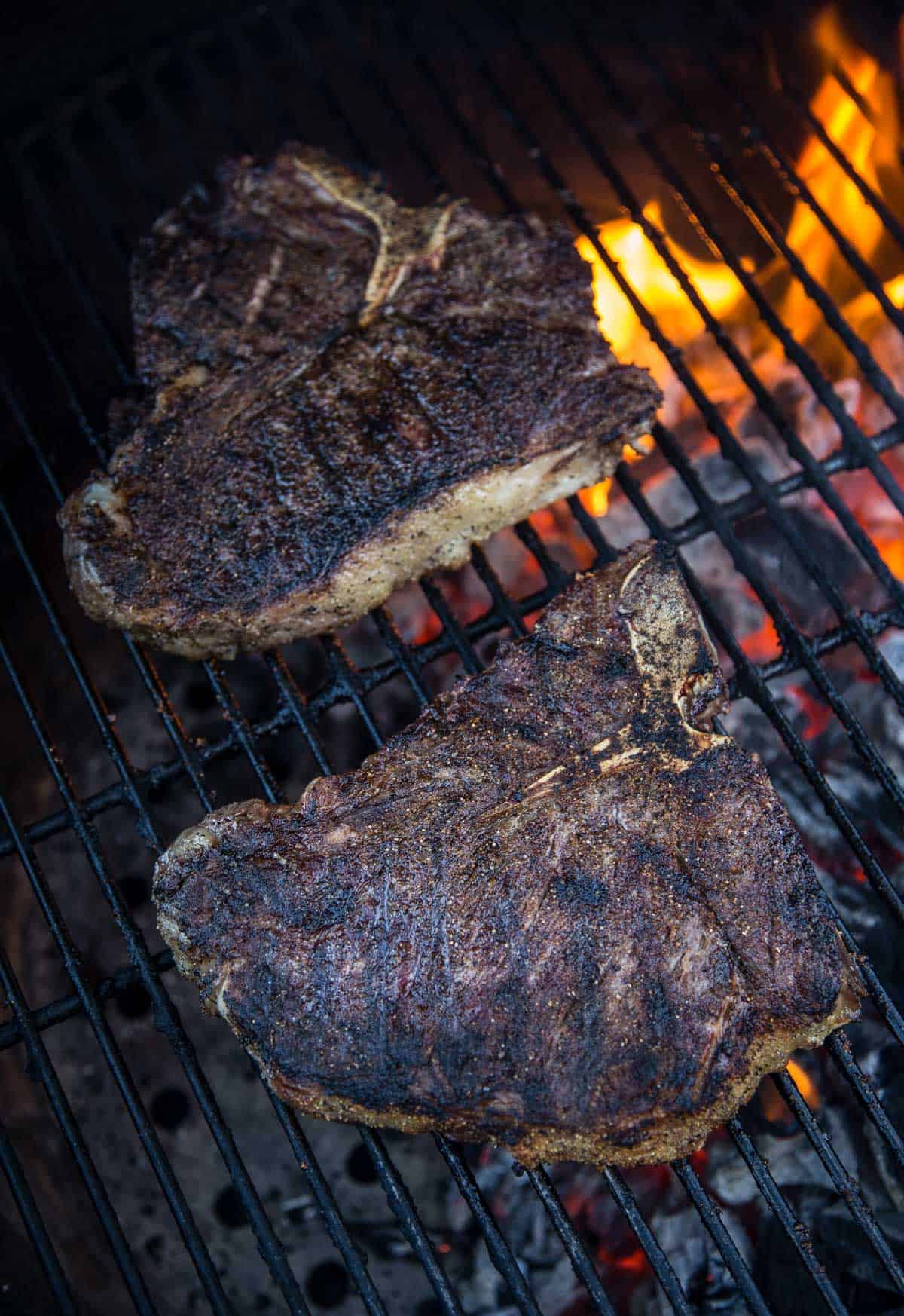
A note about taking the temperature of the T-Bone. We check the temperature in both the strip and the filet. However, we tend to pull the steak when the filet is at our desired temperature because it is leaner and will tend to come up in temperature faster. This is based on personal preference but something to note as you cook this awesome cut.
Gas Grill
If using a gas grill follow the same method of two-zone grilling. Light two burners to medium heat leaving the third burner off for an indirect zone. Place steaks over the direct side for the same timeframes. Flip and finish over indirect heat.
T-Bone Slicing Tips
After the steak has rested a T-Bone needs some finesse when slicing. If serving one steak per person just serve the entire steak with a good steak knife.
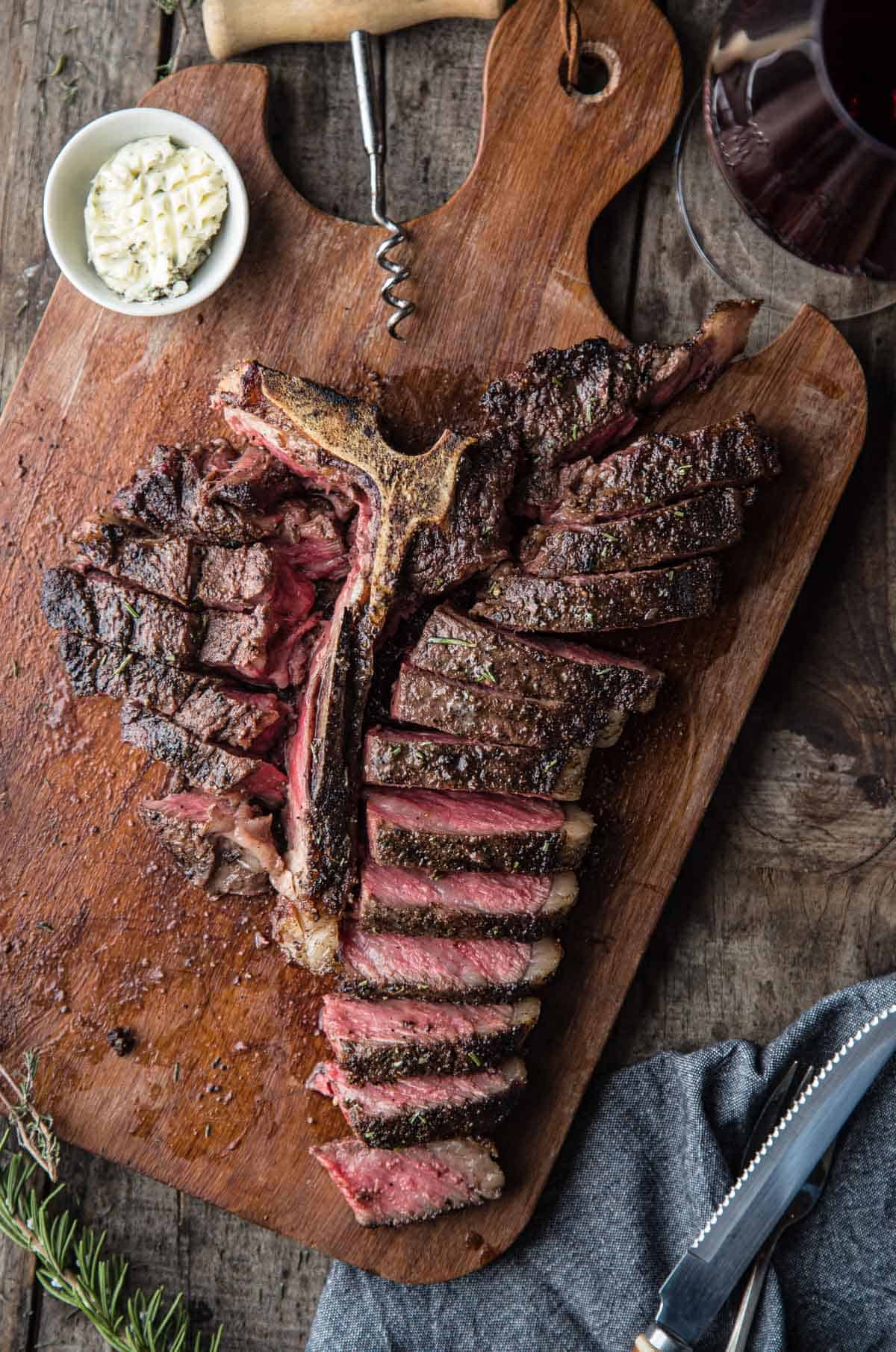
Would you like to save this?
If serving one steak per 2 people start with a sharp filet knife and separate the beef tenderloin. Then remove the strip steak from the bone. There are some angles to the bone so you want to be careful and follow along the shape of the bone and adjust your knife to meet the angles. Once the two cuts of beef are removed, slice thinly.
Reform the steak to look like the original cut and place on a serving platter with tongs.
Thin Steak Troubleshooting
If you have thin T-Bone steak the key for a perfect steak is to grill it at a high heat and for just a couple of minutes per side. The internal temperature is just as important to measure with a digital thermometer, whether you’re grilling a thin cut or thick.
Chef Steak Temperature Ranges
Perfectly cooked steaks will vary based on your preference. We like our steaks a perfect medium-rare with a cool center, juicy flavor, and a tender texture. You can read more in our article on perfectly cooked steak.
Beef Temperature Ranges
Be sure to take into consideration the carry-over cooking that happens while the steak rests. For steaks remove them 5 degrees lower than your desired temperature. For roasts remove them 10 degrees lower. The steak’s internal temperature will rise as it rests.
| Black and Blue | 100 – 120° Fahrenheit (F) | 37 – 48° Celsius (C) |
| Rare | 120 – 130° F | 48 – 54° C |
| Medium Rare | 130 – 140° F | 54 – 60° C |
| Medium | 140 – 150° F | 60 – 65° C |
| Medium Well (not recommended) | 150 – 160° F | 65 – 71° C |
| Well Done (not recommended) | 160 – 170° F | 71 – 76° C |
BBQ T-Bone Steak
Barbecue specifically refers to low and slow cooking (grill is under 325 degrees F) versus grilling, which refers to cooking hot and fast (over 45 degrees F). If you’re looking for a good BBQ T-Bone steak then use the reverse sear method for even more flavor. This method is great for thin steaks to minimize overcooking.
This means you are smoking the T-Bone steak at a low temperature, typically 225 degrees, until it is close to your desired internal temperature, and then you finish over a hot grill or cast iron pan for a sear.
Another way to add flavor is to use a compound butter. Simply add spices and herbs to room temperature butter and place on the steak as it rests.
Wine Pairing for T-Bone Steak
A wine that is big and red works for grilled T-Bone steaks. Cabernet Sauvignon is a standard and great go-to for this cut. A bolder style Merlot also works well. For an affordable option check out Malbec.
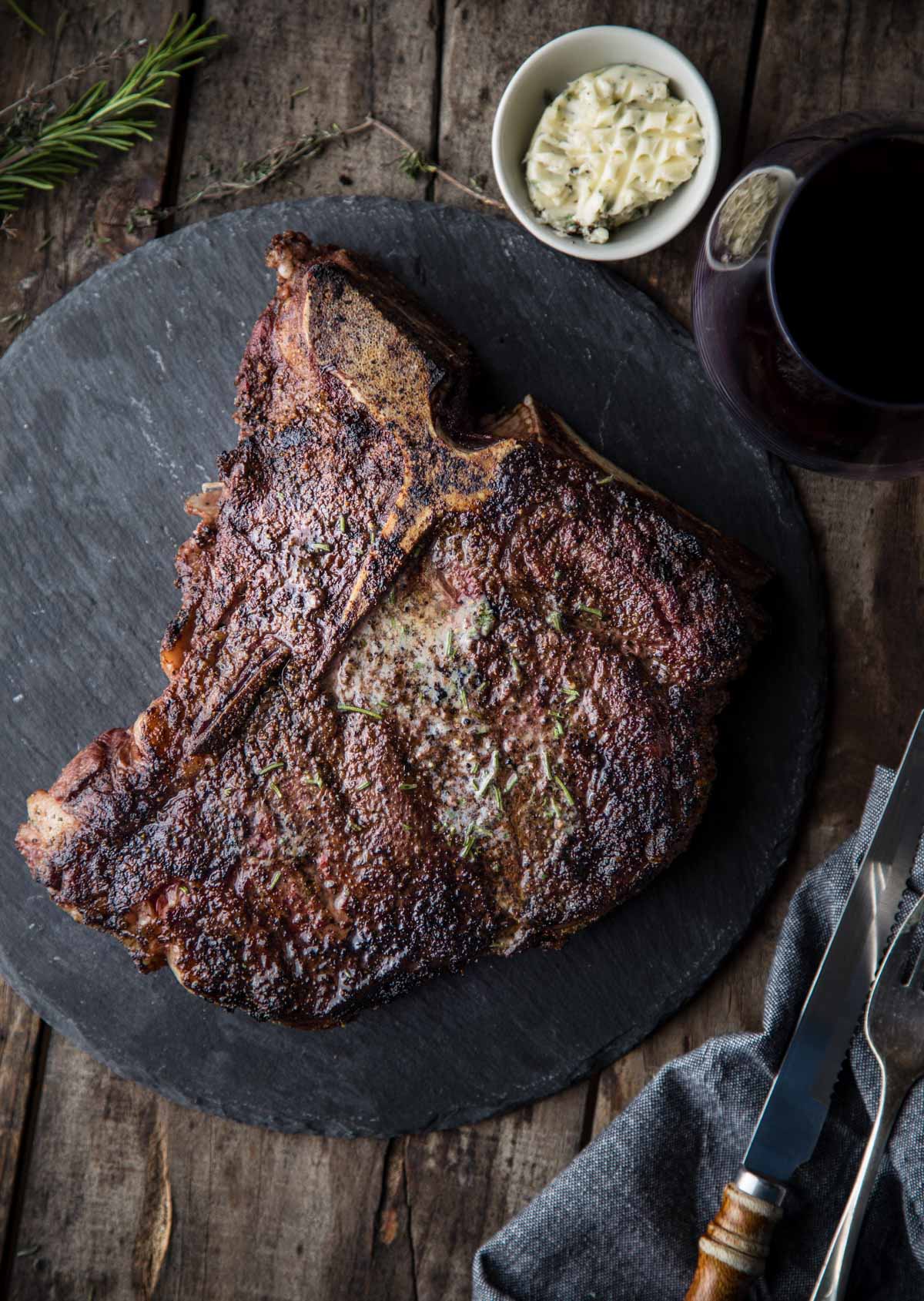
Or this is also a good opportunity to open that Barolo or Sagrantino di Montefalco that you’ve been saving for the right occasion.
Tools Used
- Instant Read Meat Thermometer – A good digital thermometer is the most important tool to own beside the grill itself. Our favorite instant-read thermometer is the Thermoworks Thermapen One or the less expensive Thermopop.
- Cutting Board – Invest in one good cutting board that can handle both raw meat and the finished steaks when they rest. Be sure you clean your cutting board between preparing and finishing the steaks.
- Long Tongs – This will help prevent burning your arm hair and hands over a hot grill.
- Lump Charcoal – We prefer lump charcoal when grilling for the more natural flavor. Our preferred brands include Big Green Egg (Green), Fogo, and Jealous Devil charcoal.
- Filet Knife – A filet knife helps to cut around the bone for presentation.
Frequently Asked Questions
No. There is a debate as to whether you should have your steaks come to room temperature prior to grilling. The idea is that it allows the steak to warm and sear better.
You will get a negligible change in the internal temperature by letting them rest and increase the likelihood of foodborne pathogens. It’s better to have a hot grill and not waste your time.
Since the steak is comprised of two different muscles, the beef tenderloin and the strip loin, it’s a tender cut of beef that is delicious when cooked properly.
Because of the marbling and tenderness of the beef tenderloin and strip loin there is no need to marinate a T-Bone.
Best Sides for T-Bone Steak
- Roasted Duck Fat Potatoes
- Perfect Restaurant Style Potatoes
- Grilled Broccolini
- Grilled Sweet Potatos
Our Favorite Steak Recipes
If you are feeling inspired here are a few more of our most popular steak recipes.
- Cowboy Ribeye – This thick cut bone-in Ribeye steak is rubbed with a coffee rub, smoked, and then grilled to perfection. It’s one of the tenderest cuts of beef.
- Grilled Tomahawk Steak – The showstopper of all grilled steak recipes is the thick cut long bone Tomahawk steak. Our recipe is perfectly grilled with our Beef Seasoning.
- Grilled Filet Mignon – Quickly grill the tender steak cut and finish with a bacon and blue cheese topping.
If you are looking for more steak inspiration head over to our steak roundup.
This recipe was originally published in March of 2020, and updated in October of 2023 with updated Q&A. The original recipe remains the same.
About Vindulge
Mary (a certified sommelier and recipe developer) and Sean (backyard pitmaster) are co-authors of the critically acclaimed cookbook, Fire + Wine, and have been creating content for the IACP nominated website Vindulge since 2009. They live in Oregon on a farm just outside Portland.
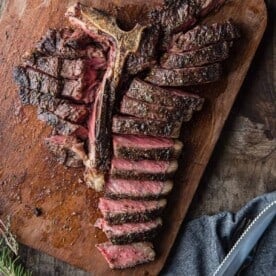
Easy Grilled T-Bone Steak Recipe
Equipment
- lump charcoal
Ingredients
- 2 T Bone Steaks, (Roughly 1 ¼ pounds each and at least 1 ½ inches thick)
- 2 tablespoon2 extra virgin olive oil (one per steak)
- 1 tablespoon kosher salt
- 1 tablespoon coarse black pepper
- 1 tablespoon granulated garlic
Instructions
- Preparation: Preheat grill using a two-zone, or direct/indirect, method using lump charcoal. Target 500 degrees Fahrenheit in the cooking chamber. Combine salt, pepper and garlic in a small bowl (this will be the dry rub). Coat the steak with olive oil, and then apply the dry rub.
- Grill Direct: Grill the steak over direct heat, roughly 4-5 minutes or until a nice crust develops. Flip the steak over direct heat and sear the other side another 2-3 minutes or until a nice crust develops, and then move the steak over indirect heat to finish.
- Grill Indirect: Continue cooking the steaks on indirect side for additional 8 – 10 minutes, or until the internal temperature of the steak is at your desired internal temperature. We pull ours at an internal temperature of 125 degrees for rare.
- Rest and Serve: Let rest for 10 minutes to allow for carry over cooking and then slice and serve with your favorite sides.
Notes
- Rare: 120-130 degrees F – Our preferred range
- Medium Rare: 130-140 degrees F
- Medium: 140-150 degrees F
- Medium Well: 150-160 degrees F
- Well Done: 160 degrees F (and not recommended)
Nutrition
Nutrition information is automatically calculated, so should only be used as an approximation.
